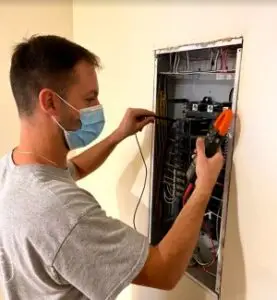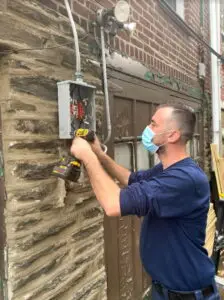Navigating Electrical Safety: Tips for Homeowners and Businesses
Embarking on a journey to ensure electrical safety in your home or business? This comprehensive guide is crafted to provide you with essential tips and insights, empowering you to navigate the realm of electrical safety effectively.
Understanding Electrical Hazards: Illuminating the Dangers
Electrical hazards lurk in various forms, from faulty wiring to outdated appliances. In this guide, we’ll shed light on common electrical dangers, helping you recognize potential threats and take proactive measures to mitigate risks. Understanding the enemy is the first step in securing a safe environment.
Securing Home Electrical Systems: A Blueprint for Safety
Your home’s electrical system is the backbone of daily life. We’ll guide you through the steps of safeguarding it, covering topics like circuit breaker maintenance, outlet inspections, and the importance of ground fault circuit interrupters (GFCIs). Uncover the secrets to a resilient and secure home electrical infrastructure.
Business Electrical Safety: Protecting Your Workspace
For businesses, electrical safety is paramount. This section addresses the unique challenges faced by commercial spaces, offering tailored advice on equipment maintenance, emergency response plans, and the implementation of preventive measures. Enhance workplace safety and ensure uninterrupted operations.
DIY Electrical Projects: Safely Navigating the Toolkit
Many homeowners enjoy tackling electrical projects themselves, but safety should always be the top priority. Let’s delve into the nuances of DIY electrical work, providing a comprehensive guide on the do’s and don’ts, essential tools for your toolkit, and understanding when it’s time to call in a professional.
The Do’s and Don’ts of DIY Electrical Work
Do:
- Educate Yourself: Before starting any electrical project, educate yourself on the basics of electrical systems, wiring, and safety protocols. Understanding the fundamentals minimizes the risk of accidents.
- Turn Off Power: Always turn off the power to the circuit you’re working on. This simple step prevents electrical shocks and ensures a safer working environment.
- Use Proper Equipment: Invest in quality tools and equipment. Using the right tools for the job enhances precision and reduces the likelihood of accidents.
- Follow Local Codes: Adhere to local electrical codes and regulations. Staying compliant ensures the safety and legality of your electrical work.
Don’t:
- Ignore Warning Signs: If you notice flickering lights, tripped breakers, or burning odors, don’t ignore these warning signs. They could indicate underlying electrical issues that require professional attention.
- Overload Circuits: Avoid overloading circuits with too many appliances or devices. Distribute electrical loads evenly to prevent overheating and potential fires.
- Skip Permits: For significant electrical projects, obtain the necessary permits. Skipping this step can lead to safety hazards and legal complications.
- Neglect Grounding: Proper grounding is crucial for electrical systems. Neglecting grounding can result in electrical malfunctions and pose serious safety risks.
Essential Tools for Your Toolkit
- Multimeter: A versatile tool for measuring voltage, current, and resistance.
- Wire Stripper: Essential for safely removing insulation from wires.
- Voltage Tester: Confirms the presence or absence of electrical current in a wire.
- Screwdrivers: A set of flathead and Phillips screwdrivers for various electrical components.
- Pliers: Useful for bending and twisting wires.
- Circuit Tester: Determines whether a circuit is live or not.
- Tape Measure: Ensures accurate placement of electrical fixtures.
When It’s Time to Call in a Professional
While many electrical projects can be DIY, certain situations require the expertise of a professional electrician. Consider calling in a professional when:
- Lack of Experience: If the project involves complex wiring or unfamiliar electrical systems, it’s safer to consult a professional.
- Safety Concerns: Any concerns about safety or doubts about your ability to complete the project safely warrant professional assistance.
- Major Installations: For major installations like a new electrical panel or whole-house rewiring, professionals ensure compliance with codes and regulations.
- Persistent Issues: If you’ve attempted DIY fixes for electrical issues, but problems persist, it’s time to bring in a professional to identify and address the root cause.
By understanding the do’s and don’ts of DIY electrical work, having the right tools in your toolkit, and recognizing when to call in a professional, you’ll navigate your electrical projects with confidence and safety in mind.
Emergency Preparedness: A Shock-Proof Plan
Accidents can happen despite our best efforts. We’ll guide you in creating an emergency plan for electrical incidents, from power outages to electrical fires. Being prepared ensures a swift and informed response, minimizing potential damage and protecting lives.
Choosing the Right Electrician: A Partner in Safety
The journey to electrical safety often requires the expertise of a professional electrician. Discover the qualities to look for in a reliable electrician, understand the importance of certifications, and ensure that your chosen partner is committed to the highest safety standards.
Embark on this voyage toward electrical safety with confidence. By the end of this guide, you’ll be equipped with the knowledge and tools to create a secure electrical environment for your home or business.



